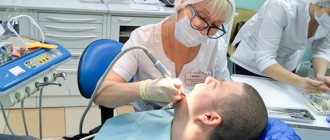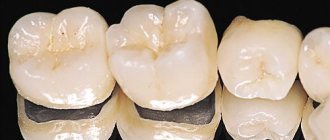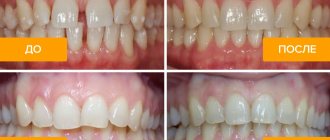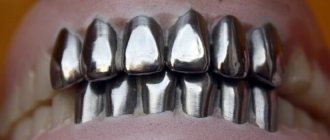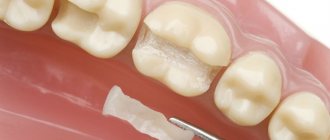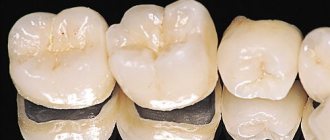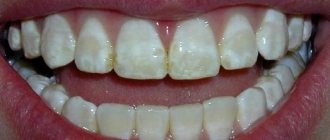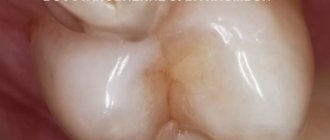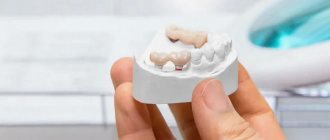From this article you will learn:
- what is Emax – reviews, before and after photos,
- its comparison with zirconium dioxide,
- Emax crowns and veneers – price 2022.
Metal-free ceramics E-max is the best option for dental prosthetics with crowns, veneers, and bridges up to 3 units in length. This material provides excellent aesthetics, and if you want artificial dental crowns or veneers to blend in as closely as possible with adjacent teeth in color and translucency, Emax material is a good choice. It is produced for dentistry (Liechtenstein).
Emax ceramics consists of 70% lithium disilicate crystals, which allows this material to be classified as glass ceramics. Thanks to the optical parameters of the glass matrix, this material has increased light transmittance, which makes its optical properties as similar as possible to the enamel of real teeth. Therefore, reviews of E-max ceramic crowns or veneers made from this material are good even among the most aesthetically demanding patients.
Appearance and transparency of E-max –
In this article we will discuss both the advantages and disadvantages of E-max ceramics, which make its use undesirable in a number of clinical situations. We will also compare E-max veneers and ceramic crowns with other types of metal-free ceramics (for example, zirconium dioxide or feldspathic ceramics) so that you can understand which denture ceramics will be best in your case.
Types of E-max ceramics –
There are 2 main options for E-max ceramics for the manufacture of veneers and crowns - these are “IPS E-max RPESS” and “IPS E-max CAD”. The indications for their use are very different, as are the technologies for making restorations from these materials, and therefore we will talk about each of them separately.
1) IPS “E-max RPESS” (pressed ceramics) –
E-max RPESS is a glass ceramic designed for injection molding under high temperature and pressure conditions. Pressed ceramics E-max has a very high strength - 400 MPa, which is several times greater than the strength not only of pressed ceramics made from any other materials, but also the strength of E-max CAD.
The excellent aesthetics of the material, together with high strength, make it possible to make from E-max RPESS not only single crowns, but also bridges of up to 3 units inclusive, and even ultra-thin veneers and lumineers. E.max RPESS significantly exceeds the aesthetic capabilities of another type of metal-free ceramic - zirconium dioxide, both due to the greater transparency of the material and due to a greater number of color shade options (Fig. 4-9).
Clinical case No. 1 – before and after photos
Clinical case No. 2 – before and after photos
In addition to the classic material “E-max RPESS”, there is also an improved version called “E-max RPESS Multi”. The second material differs from the first in that it is polychrome (that is, it has a gradient of color and transparency). Why is this, and why is it important... The fact is that in real teeth, the cutting edge and lateral surfaces of the teeth are whiter and more transparent, and in the area of the neck and center of the crown, the tooth is as opaque as possible and usually has a yellowish tint.
The regular E-max RPESS material has one tone and translucency, which is why only “layered” veneers and E-max crowns are made from it. “Layered” means that only the crown frame (cap) is made by pressing, on top of which layers of porcelain mass and dyes are then applied, which give the veneer or crown its final appearance. Using different shades of porcelain mass on the surface of the pressed cap it is possible to create a gradient of color and transparency (24stoma.ru).
Important: E-max RPESS Multi already has a gradient of color and transparency, and therefore it can be used to make monolithic crowns and veneers, which will consist entirely of pressed material (without layers of porcelain mass on the surface). And the final addition of color and shine will be carried out using dyes and the glazing process. As a result, monolithic veneers and crowns made of E-max pressed ceramics will be much more reliable and practically not susceptible to ceramic chips.
E max crowns: patient videos before and after
2) IPS “E-max CAD” (3D milling method) –
E-max CAD are lithium disilicate blocks designed for milling on a computer-controlled machine using CAD/CAM technology. This is a modern method of making crowns and veneers, with virtually no human intervention. The strength of E-max CAD is about 360 MPa, which is slightly less than that of E-max RPESS pressed ceramic. That is why it is recommended to make only single crowns and veneers of standard thickness from this material.
Another disadvantage of E-max CAD is that there are fewer possibilities for selecting shades, which sometimes may not allow achieving an ideal match in color and transparency of crowns with neighboring teeth. By the way, it is CAD/CAM technology that produces crowns and veneers from zirconium dioxide. How the process of milling crowns from E-max CAD occurs – see the video below.
Clinical case No. 3 – before and after photos
Clinical case No. 4 – before and after photos
So which is better - E-max RPESS or E-max CAD?
E-max RPESS material is the best material both in terms of strength characteristics and the ability to achieve ideal aesthetics. In addition, the production of crowns and veneers from E-max RPESS does not require expensive equipment (unlike E-max CAD), which at the same time means a more acceptable cost for patients.
Moreover, the best option would be to use not the usual plain material “E-max RPESS”, but the pre-colored “E-max RPESS Multi”. The blocks of the latter have a gradient of color and transparency, which will allow, without additional staining and application of layers of porcelain mass, to obtain the same gradient of color and transparency from the center of the crown to its cutting edge. In this case, crowns and veneers can be made as monolithic pressed ceramics, i.e. without additional application of porcelain mass to the surface of the pressed crown frame. This will protect you from chipping the ceramics.
Making crowns from E-max CAD: video
Five advantages of Emax crowns
The main feature of crowns is that they are one of the most versatile and at the same time high-quality single prostheses. They have virtually no drawbacks both from a functional and aesthetic point of view.
Aesthetics
This is one of the best options for aesthetic restorations. Thanks to proprietary manufacturing technology, the doctor can adjust the color and level of transparency of the crown. The result is complete external compliance with the natural dentition.
Biocompatibility
The Emax metal-free pressed ceramic crown has good biocompatibility and is completely hypoallergenic, and it does not wear off antagonists.
Life time
May exceed 15 years. This is one of the highest rates among similar structures.
Make an appointment
right now!
Bagiryan Avanes Nelsonovich
Surgeon, Therapist, Orthopedist
Gentle installation
To fix the all-ceramic structure, the dentist needs to remove a small layer of tooth enamel.
Lightness of designs
There is no metal in the crowns, so they are practically weightless. The surrounding tissues are not subject to excessive stress.
Secure fit
The crown cap fits very tightly to the base without irritating the gums. This prevents food debris from accumulating around the crown.
Color selection process for future restorations
E-max veneers and crowns: reviews
When it comes to metal-free ceramic options for the manufacture of ceramic crowns, veneers or bridges, the choice is always between E-max and zirconium dioxide. Of course, there is also feldspathic ceramics, which, although it has very good aesthetics, still has very modest strength (which is why we are not considering it).
And to be brief, E-max is primarily about aesthetics, and zirconium dioxide is primarily about strength. Below we will compare these 2 types of metal-free ceramics according to these criteria and talk about the optimal indications for the use of each of them.
Aesthetics -
A veneer or ceramic crown on a tooth made from E-max has truly impeccable aesthetics. This is due to the fact that lithium disilicate glass ceramics have a high degree of transparency, which is almost identical to natural tooth enamel. Therefore, if you have high transparency of tooth enamel, a good dentist will offer you only E-max.
In addition, a very important factor that ensures an exact match in appearance of an artificial crown or veneer with neighboring teeth is the choice of a wide range of material shades. And here it must be said that the E-max ceramic system has a significantly larger range of shades, which significantly increases the dental technician’s chances of achieving an exact match of the color of artificial crowns with neighboring teeth (Fig. 18-22).
Clinical case No. 5 – before and after photos
Clinical case No. 6 – before and after photos
Aesthetics of zirconium dioxide crowns –
But the use of zirconium dioxide on the front teeth most often disappoints patients. This is due to the fact that, firstly, the zirconium frame has little light transmission (transparency), and secondly, when working with zirconium dioxide, the dental technician is more limited in the choice of color shades than when working with E-max. Ultimately, all this does not allow making crowns and veneers made of zirconium dioxide as similar as possible to real teeth.
Therefore , if you take a good look at most “before and after photos” of zirconium crowns and veneers, you will notice that in 90% of cases they will be quite different in color and transparency from the neighboring real teeth. Most often they will be completely opaque, and often have an unnatural bright white (milky) color. Although zirconium dioxide certainly does not reach E-max in aesthetics, this does not mean that veneers and crowns made from it can only be opaque and milky in color.
The fact is that zirconium dioxide blocks from different manufacturers are very different from each other. Dental clinics most often use white, opaque zirconium dioxide blocks for milling crowns (which is why the finished crowns look similar) due to their lower price. However, there are also translucent zirconium dioxide blocks, for example, Prettau® Anterior, which allow you to achieve aesthetics that are already quite acceptable for the front teeth.
Strength –
E-max ceramics has a fairly high strength - 360-400 MPa.
This is more than enough for single crowns on the front and posterior teeth, veneers and lumineers, as well as 3-unit bridges. However, bridges are made mainly only on the front teeth (the far support of the bridge should not be located further than the 5th tooth). In turn, zirconium dioxide has a strength of 1200 MPa, which is comparable to metal. Thanks to this, bridges of any length can be made from this material. Therefore, if you need to make a bridge on the chewing teeth, or a bridge of 4 or more units in the area of the front teeth, then zirconium dioxide is the clear choice.
Ceramic chips – it must be said that there is a weak link in the strength of zirconium crowns, which often leads to ceramic chips. The fact is that zirconium bridges and crowns are rarely made of monolithic zirconium dioxide, and most often they consist of a milled zirconium frame, which is lined with porcelain on the outside. The surface layer of porcelain is necessary here to make the crowns more similar to real teeth in terms of aesthetics.
The weak link here is the chips of the porcelain mass from the surface of the zirconium frame. Statistics show that within 3 years from the moment the crowns were made, they occur in no less than 6% of patients. The reason is the deterioration of the bond between zirconium and porcelain over time. For example, ceramic chips in metal-ceramic crowns occur even 2 times less frequently than in zirconium crowns (despite the fact that the strength of the connection between porcelain and the metal frame is only about 100 MPa). From this it turns out that the strength of the connection between porcelain and zirconium dioxide is even worse than the strength of the connection between porcelain and metal in metal-ceramic crowns.
However, chipping occurs even less frequently when using E-max pressed ceramics. Therefore, if you only need a single crown (and it does not matter - on the front or even the chewing tooth), or you need a bridge of 3 units on the front teeth, again the E-max will be the best choice. The best choice for zirconium dioxide ceramics would be bridges on chewing teeth, preferably made from monolithic zirconium dioxide.
What is pressed ceramics
Pressed ceramics, which e.max refers to, means a glass-ceramic material based on lithium disilicate, which specialists obtain by hot pressing and heat treatment. In another way, this type of ceramic is also called lithium disilicate.
Compared to conventional ceramics, lithium silicate is considered universal: it is equally suitable for teeth located in the smile area and for chewing units. It is also very durable and wear-resistant, it has fewer pores and has a perfectly smooth, even surface, which not only exactly recreates the structure of natural enamel and looks very beautiful, but also provides the future structure with protection from the attack and settling of pathogenic bacteria, and from the accumulation of plaque , from the penetration of coloring pigment and the accumulation of odor - all this also contributes to the prevention of dental diseases in the oral cavity of a person who has an orthopedic structure installed.
According to clinical studies conducted by Ivoclar Vivadent, the strength of IPS e.max ceramics is 500 MPa1 (while conventional values are within 100 MPa). Also, thanks to these characteristics, the improved innovative material gives dental technicians the opportunity to make an all-ceramic crown very thin (the minimum wall thickness is one millimeter), and orthopedic dentists, who will subsequently install it, to carry out minimal grinding and preparation of the tooth in need of restoration.
Summary -
E-max will be the best choice –
- single crowns (regardless of location),
- 3-unit bridges for the front teeth,
- veneers,
- lumineers (thickness from only 0.3 mm),
- if the patient has high aesthetic requirements,
- if the patient has high transparency of tooth enamel.
Zirconium would be the best choice –
- bridges on chewing teeth,
- bridges of 4 or more units,
- single crown supported by an implant,
- bridge prosthesis supported by implants,
- if the patient has bruxism.
E-max crowns: price 2022
How much does a ceramic crown cost per tooth in mid-price clinics? First of all, this will depend on which version of the E.max material the veneer or crown will be made from and, accordingly, what technology will be used (this can be either a pressing technique or CAD/CAM technology).
Ceramic crown for a tooth: price for 1 unit
- A crown made from Emax PRESS material will cost you an average of 21,000 rubles, and a veneer made from this material will cost you approximately 25,000 rubles. Moreover, most often when ordering 4 or 6 veneers at once, clinics give a discount of approximately 15-20%.
- A crown made of Emax CAD material will cost at least 30,000 rubles. 20,000 rubles.
Moreover, it should be taken into account that this cost usually does not include temporary crowns made of plastic (the cost of 1 temporary crown is additionally about 1500-2000 rubles). By the way, in the regions of Russia the price of the Emax PRESS ceramic crown will be slightly lower, for example, it can be about 18,000 rubles.
Disadvantages and contraindications
However, with all the advantages of crowns made from the E.max material, the system may not be suitable for everyone. Contraindications include the habit of strongly clenching the jaw (bruxism), malocclusion, extensive caries, large composite fillings, which can negatively affect the strength of the dentures. However, these are the disadvantages of all ceramic crowns.
It is important not to forget that crowns made of pressed ceramics, due to their lower strength than those based on zirconium dioxide, are more suitable for single restorations of anterior and lateral units, as well as for bridges of four (no more) crowns in the chewing area - with regard to the creation of bridge structures It is fair to say that the manufacturer suggests using a combination of IPS e.max CAD and ZirCAD blanks.
Don't know what type of prosthetics to choose?
We will help in the selection, advise where to read more information and compare types of prosthetics.
Consultation with an orthopedic doctor in Moscow clinics is free! Call now or request a call
Working hours: from 9:00 to 21:00 - seven days a week
Also, crowns made from the E.max material cannot boast an affordable price, and due to the fairly high cost, not all patients decide to evaluate their benefits in the initial and long term.
Disadvantages of E-max –
- High cost - compared to standard metal ceramics (but at the same time it is comparable to the cost of highly aesthetic metal ceramics with “shoulder mass”),
- not on chewing teeth (on 6-7-8),
- not allowed with bruxism,
- it is impossible if the stump of the ground tooth is dark in color,
- it is not advisable if there are a large number of missing teeth (in this case, the entire chewing load is not distributed evenly, but only on the remaining teeth, leading to their overload). We hope that our article on the topic: E-max metal-free ceramic crown, price, reviews was useful to you!
Sources :
1. Personal experience as a dentist, 2. National Library of Medicine (USA), 3. Harvard Medical School (USA), 4. https://www.ivoclarvivadent.us/, 5. https://www .realself.com/, 6. “Crowns and bridges in prosthetic dentistry” (Smith B.).
The difference between a metal-ceramic crown and non-metal ceramics
Metal-ceramic crowns have been used in orthopedics for more than 35 years. They consist of a frame based on an alloy of chromium with cobalt or nickel and a ceramic coating. The products are durable, can withstand heavy loads, and last more than 10 years. But compared to metal-free products, metal ceramics have a number of disadvantages:
- mandatory depulpation and grinding of the tooth before installation;
- possibility of allergy to metal;
- the risk of gum subsidence and exposure of the metal base;
- chips of ceramics are possible;
- poor light transmission, which makes the prosthesis look unnatural.
In our Center, after switching to digital milling in 2000, we completely abandoned metal-ceramics in favor of metal-free products.

